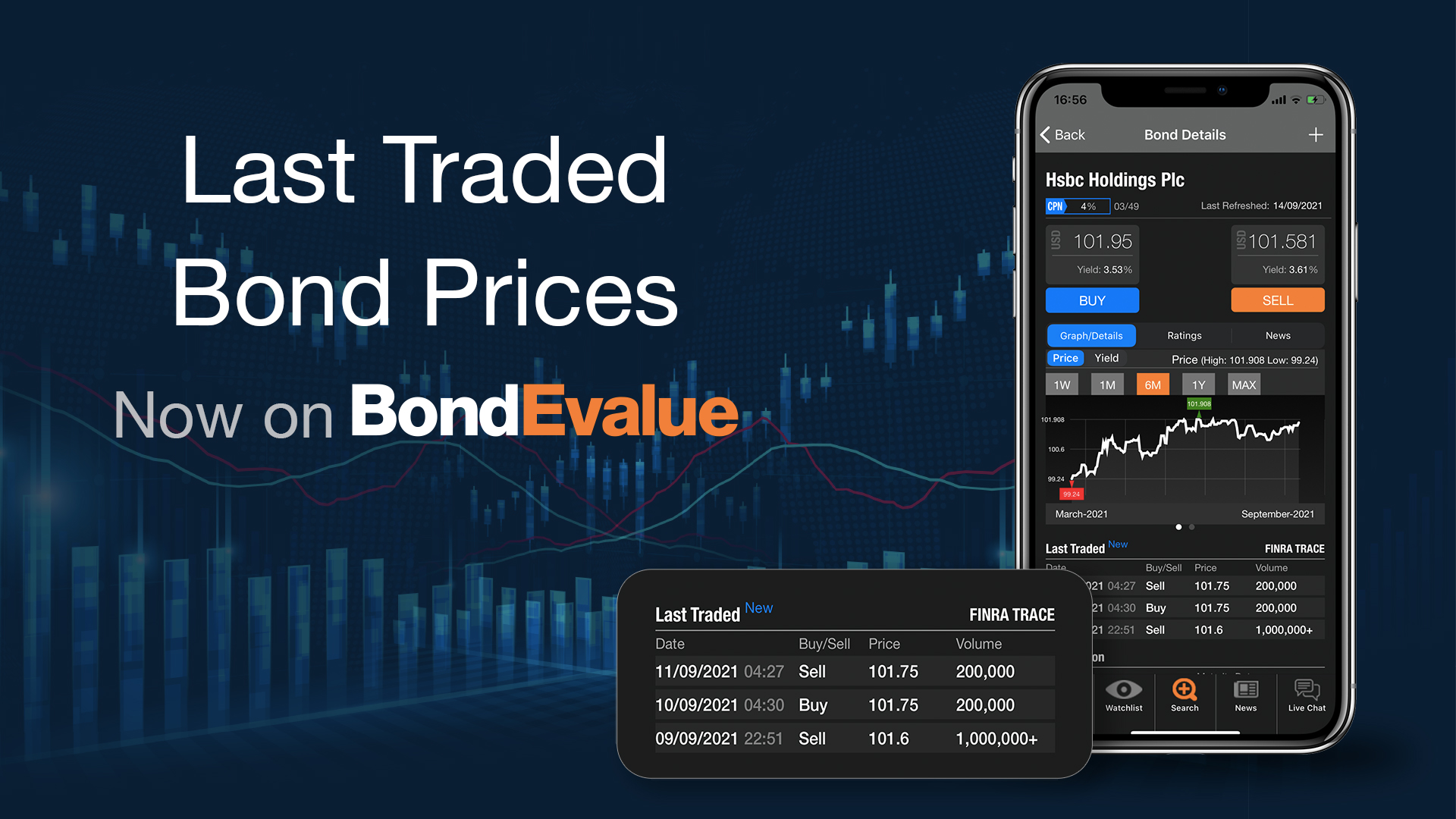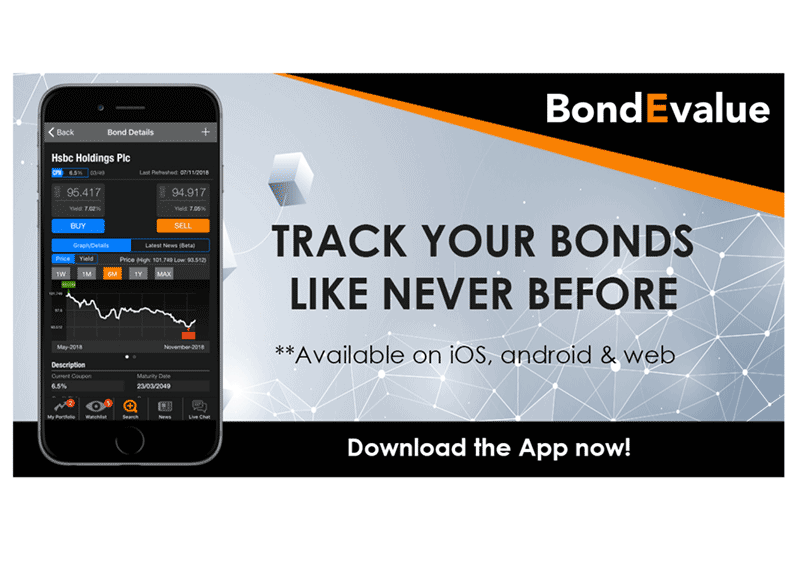This site uses cookies to provide you with a great user experience. By using BondbloX, you accept our use of cookies.
Bond Market News
Last Traded Bond Prices by FINRA TRACE – Now on the BondbloX App
December 10, 2024

What is TRACE?
TRACE (Trade Reporting and Compliance Engine®) is the Financial Industry Regulatory Authority’s (FINRA) fixed income market real-time price reporting and dissemination service.
Bond markets predominantly work on an over-the-counter (OTC) basis where a bond buyer and seller typically need to speak over the phone to transact with little to no use of technology. Another major issue with OTC trading is the lack of transparency in bond prices. Investors, especially individual investors, have to rely on their bank/broker to find out the price of a bond. To combat this problem, FINRA introduced TRACE in July 2002 as a vehicle to consolidate transaction data for all eligible public and private corporate bonds, agency debt, securitized products including asset-backed securities (ABS) and mortgage-backed securities (MBS). TRACE facilitates mandatory reporting of OTC transactions by member broker-dealer in the above TRACE eligible securities.
Thus, TRACE data consists of information on actual OTC bond trades including the trade price, trade volume and trade direction. This data can be extremely useful to investors and can serve as a benchmark for the price of a particular bond, especially when the trade has taken place recently.
What is FINRA?
Financial Industry Regulatory Authority (FINRA) is a government-authorized not-for-profit organization that oversees US brokerage firms and exchange markets. FINRA is supervised by the US regulator Securities and Exchange Commission (SEC). FINRA:
- Writes and enforces rules governing ethical activities of all registered broker-dealer firms and registered brokers in the US
- Examines firms for compliance with those rules
- Fosters market transparency
- Provides investor education
How can TRACE data be used?
TRACE data can be extremely useful for market participants including investors and advisors as it serves as a benchmark for a particular bond’s price at a given point in time. Without this data, market participants, particularly individual investors have no information on the price at which a particular bond has actually traded. This information gap can sometimes be exploited by intermediaries by adding spreads/commissions to bond prices. With the dissemination of TRACE data, investors can compare the bond price being offered to them to actual trade prices of a particular bond to ensure that they are being offered a reasonably fair price.
We at BondbloX have always called for more transparency in the bond markets by leveraging technology. Our App, which has been providing evaluated bond prices to thousands of bond investors globally, now also offers TRACE data. Investors and advisors can thus access both evaluated and traded prices of bonds on the same screen. This serves as a strong reference point, particularly when transacting as investors can see what the evaluated price is based on quotes from interbank sources and where the bond actually traded at in the past. Data on actual bond trades is particularly useful for bonds that have wide bid-ask spreads or bonds that are relatively less liquid.
Do All Bonds Have TRACE Data?
Not all bonds have TRACE data. Only broker/dealers who are FINRA member firms have an obligation to report transactions to TRACE under an SEC approved set of rules. Rule 6710 generally defines a “TRACE-Eligible Security” as: (1) a debt security that is USD denominated and issued by a US or foreign private issuer and, if a “restricted security” as defined in Securities Act Rule 144(a)(3), sold pursuant to Securities Act Rule 144A; or (2) a debt security that is USD denominated and issued or guaranteed by an “Agency” as defined in Rule 6710(k) or a “Government-Sponsored Enterprise” as defined in Rule 6710(n).
Interpreting TRACE Data from the BondbloX App
On the BondbloX App, TRACE data is reported and disseminated from the dealer’s perspective. This means that a dealer is either buying or selling to another dealer or a customer. FINRA only disseminates secondary market transactions on TRACE. Below, we provide an example from the BondbloX App of TRACE data on HSBC’s 4% Perps callable in 2026 and how to interpret it.
- The actual last traded price with the date of the transaction. This appears between the Buy and Sell prices, which are evaluated prices from our bond pricing algo. For bonds that do not have TRACE data, the last traded price will not appear.
- Below the chart, we have the with FINRA TRACE “Last Traded” data that indicates the last three trades (if available). For bonds that do not have TRACE data, the “Last Traded” section will not be present
- From the left, we have the date (DD/MM/YYYY) and the time (HH:MM) at which the last three trades took place. The time is based on your time-zone. For example, if a user is based in Singapore, the time is in SGT and for a user based in India, the time is IST.
- Here we provide the prices at which each of these trades were transacted between the parties
- The trade volume, stated in terms of a par value of $1,000 – hence dividing the volume by 1,000 shows the number of bonds transacted. In the above example, 300 bonds (of notional amount $300,000) were transacted at 101.693; over 1,000 bonds (of over notional amount $1,000,000) were transacted at 101.66; and 601 bonds (of notional amount $601,000) were transacted at 101.91.
- The next column features the type of transaction as to whether it is a Buy/Sell transaction. Here it is given in terms of whether the dealer reporting to TRACE bought or sold the bonds. A ‘Buy’ transaction indicates that the dealer bought the bonds, while a ‘Sell’ transaction indicates that the dealer sold the bonds.
- The last column indicates the parties to the trade. There are two types of parties:
- Reporting Party: In most cases, this is the broker-dealer (dealer) that reports the trade. If the dealer does not report the trade, it could be an Alternative Trading System (ATS, explained below).
- Contra Party: This indicates the party on the other side of the transaction and can contain one of the following
- Another Dealer
- A Customer (non FINRA member)
- An Affiliate (non FINRA Member that is an affiliate of the reporting party – for example, a trade between Goldman Sachs (North America) and Goldman Sachs International (Europe), or a trade between UBS (dealer) and UBS Wealth Management)
- An Alternative Trading System (ATS)
An Alternative Trading System (ATS) is an SEC-regulated electronic trading system that acts like an exchange to match buy and sell orders but is not necessarily required to register as a national securities exchange. They help provide an alternate access to liquidity. Examples of ATS include Interactive Brokers’ ATS, Tradeweb Direct, MarketAxess ATS, ICAP ATS, IDX Markets ATS etc.
Conclusion
TRACE data from FINRA therefore acts as one more layer to enhance transparency with respect to bond prices. Investors should thus make it a point to review actual traded bond prices along with indicative or evaluated bond prices, available on the BondbloX App, to track the value of their bond investments on a day-to-day basis and before transacting on a bond. Lastly, the history of the last few trades may also help judge whether the bond’s price has been moving higher or lower.
Disclaimer
The materials and information contained herein are solely for general information reference and educational purposes only, and not intended to constitute nor as a substitute for legal, commercial and/or financial advice from an independent licensed or qualified professional. The information, opinions and views expressed herein are not, and shall not constitute an offer or a recommendation to sell, a solicitation of an offer to buy or an offer to purchase any securities, nor should it be deemed to be an offer, or a solicitation of an offer, or a recommendation, to purchase or sell any investment product or service or engage in any investment strategy. Nothing herein has been tailored to the investment objectives or financial situation of any specific individual, are current only as of the date hereof and may be subject to change at any time without prior notice. No representation, warranty or claim whatsoever is made nor implied as to the accuracy or completeness of any material or information contained herein, nor we have no liability whatsoever for any error, inaccuracies or omissions. No reliance should be made on the materials or information herein for any investment decision, and we accept no liability whatsoever for any direct or indirect loss whatsoever which may arise from the use or reliance of any such material or information. The business of investing is a complicated matter that requires serious financial due diligence for each investment. No representation whatsoever on the suitability or otherwise of any securities, products, or services for any particular investor. Each investor is solely responsible for its own independent investment decision based on its personal investment objectives, financial circumstances and risk tolerance, and should seek its own independent legal, tax and other professional advice prior to any such decision.
The inclusion of any hyperlinks or external links should not be seen as an endorsement or recommendation of that website or the views expressed therein. We do not have any control over the content or actions of the websites we link to and will not be liable for anything that occurs in connection with the use of such websites.
Go back to Latest bond Market News
Related Posts:
High-Yield Bonds Lead The July Recovery
August 6, 2018

Bond Yields – Explained
December 26, 2024

What to Look for When Buying Bonds
December 4, 2024






